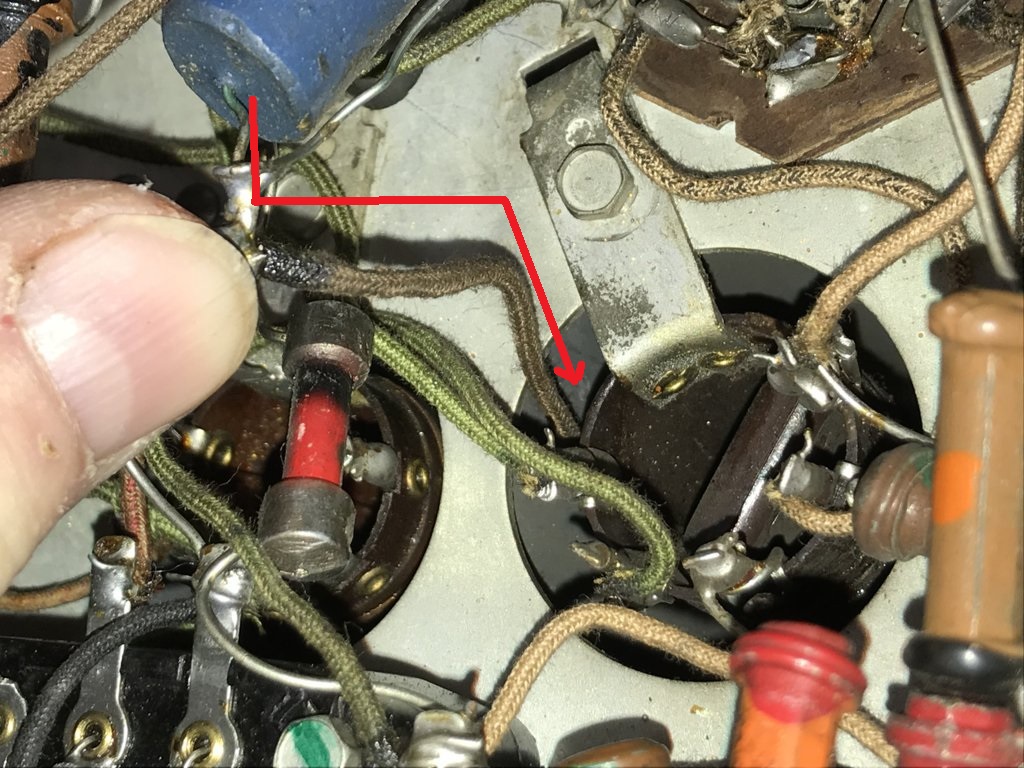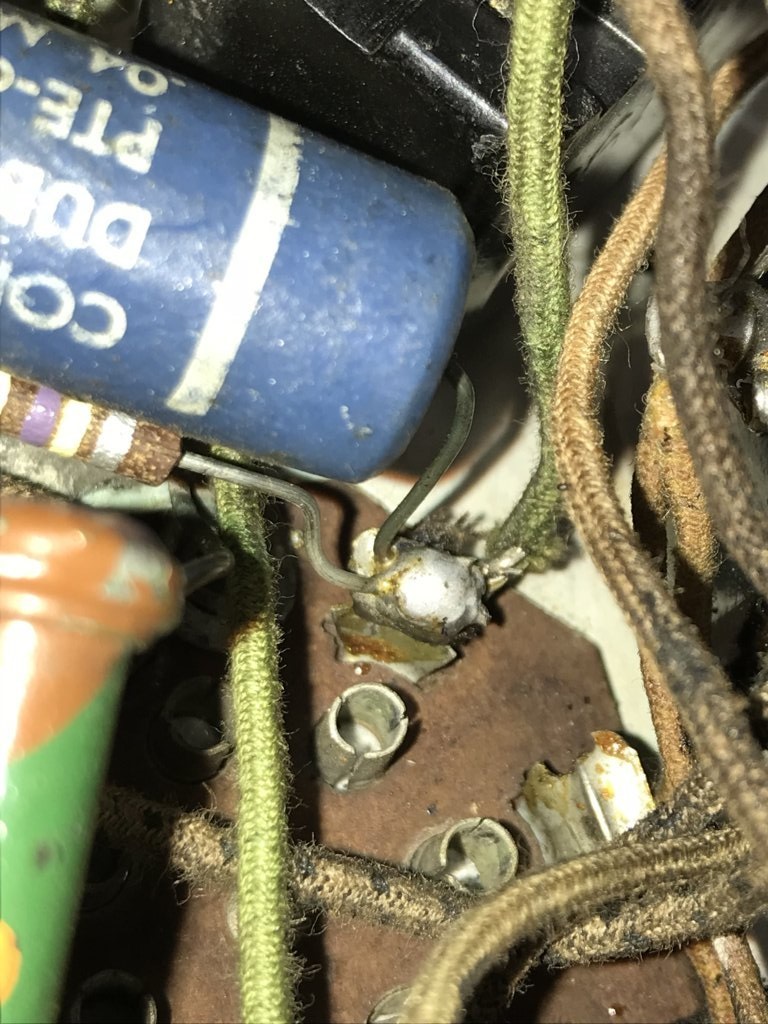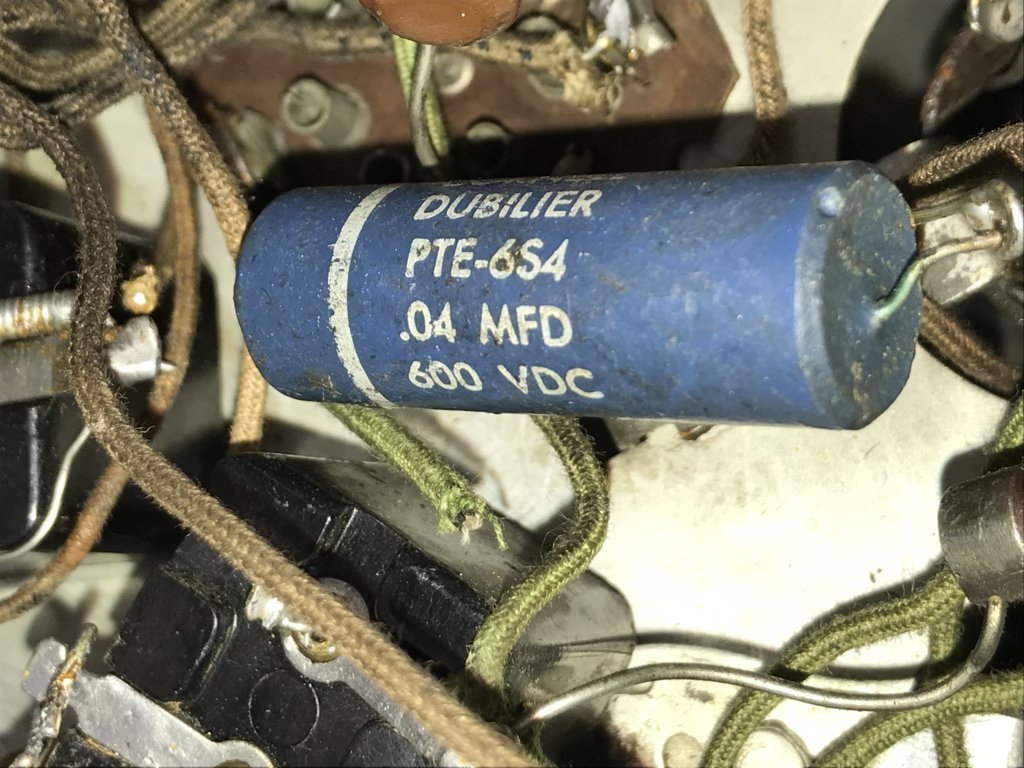Posts: 16,508
Threads: 572
Joined: Oct 2011
City: Jackson
State, Province, Country: NJ
No this is the sch I had when tackling mine.
The sch shows the cap of 0.18uF which is physically a backelite with the two caps, two of the ends connected to the GND screw, and two separately connected with that bare wire (middle and left), the flex 200 ohm resistor going from the left pin to GND screw terminal.
It is in perfect agreement with the schematic.
People who do not drink, do not smoke, do not eat red meat will one day feel really stupid lying there and dying from nothing.
Posts: 5,170
Threads: 274
Joined: Nov 2012
City: Wilsonville
State, Province, Country: OR
OK...so there are many versions of the 60 schematic and they are nicely documented by Ron at the following LINK.
You may have Run 3, which has the extra 5th lead coming from cap can #20 that connects to cap #8.
If you look at Run 2, they added a .02uF paper cap and then in Run 3 incorporated that paper cap into the larger condenser can.
Posts: 189
Threads: 22
Joined: Aug 2018
City: Kewanee
State, Province, Country: Illinois
Awesome, thank you both!
1929 Victor R-32, 1933 60L, Phil 40-158, Phil 42-400X, Phil 47-1230 Radio/Phono,, 1950 Phil TV t-1104, Air King 4000, Philco 41-105, Philco 37-675, RCA Victor 9K2, PT-50, Phil 54C, PT-44 Cabinet, Phil 118X Cabinet
Gregg 
Posts: 7,301
Threads: 269
Joined: Dec 2009
City: Roslyn Pa
>The sch shows the cap of 0.18uF which is physically a bakelite with the two caps, two of the ends connected to the GND screw
Just to clear up perhaps a little confusion I'm not sure why but Philco back in the late '20s used .09mfd caps and continued to use them in to the '30s. It's a non standard value. That's how your model 60 has a .18mfd it's two .09's in parallel. Perfectly fine to use a couple of .1mfd cap to replace the .18mfd.
When my pals were reading comic books
I was down in the basement in my dad's
workshop. Perusing his Sam's Photofoacts
Vol 1-50 admiring the old set and trying to
figure out what all those squiggly meant.
Circa 1966
Now I think I've got!
Terry
Posts: 189
Threads: 22
Joined: Aug 2018
City: Kewanee
State, Province, Country: Illinois
 11-05-2018, 01:16 AM
11-05-2018, 01:16 AM
Thanks Terry, Bob and Mike, yes you have all cleared it up for me, and I do indeed have the Run 3 Chassis. That schematic you posted is what I have and is why I was confused. Being new to this hobby I have a lot to learn, and I appreciate both your patience and assistance. I bought my schematic off of Steve's Antique Technology and did not realize there had been a schematic / parts change (run 3). All of you have helped tremendously.
1929 Victor R-32, 1933 60L, Phil 40-158, Phil 42-400X, Phil 47-1230 Radio/Phono,, 1950 Phil TV t-1104, Air King 4000, Philco 41-105, Philco 37-675, RCA Victor 9K2, PT-50, Phil 54C, PT-44 Cabinet, Phil 118X Cabinet
Gregg 
(This post was last modified: 11-07-2018, 10:52 AM by Greggshere.)
Posts: 16,508
Threads: 572
Joined: Oct 2011
City: Jackson
State, Province, Country: NJ
Yes, 0.1uF is what I used. These values most times are not critical.
People who do not drink, do not smoke, do not eat red meat will one day feel really stupid lying there and dying from nothing.
Posts: 16,508
Threads: 572
Joined: Oct 2011
City: Jackson
State, Province, Country: NJ
https://www.mouser.com/ProductDetail/Cor...g4UM9lI%3d
Just to clear.....0.18uF is also a standard value today (0.09uF is not) and is stock in Mouser (the link above).
However this i rarely needed in radios and 0.1uF is a very popular value so I use two of 0.1uF instead.
People who do not drink, do not smoke, do not eat red meat will one day feel really stupid lying there and dying from nothing.
Posts: 4,896
Threads: 54
Joined: Sep 2008
City: Sandwick, BC, CA
I don't know if this is true or not but I remember reading somewhere that paper capacitors of the 1930s and 40s , had a tolerance of + or - 20%, which may be optimistic. So if the schematic calls for a .09 mf cap use a .1 mf, since a modern film cap is probably closer to spec then the original.
Regards
Arran
Posts: 189
Threads: 22
Joined: Aug 2018
City: Kewanee
State, Province, Country: Illinois
I did use the .1 caps in that Bakelite condenser. Also, on the AC power in condenser block I installed a .015 safety cap. and per the service update I was going to add a second .015 for the other line, but I couldn’t physically fit two .015 safety caps. in it. I used a physically smaller .01 safety cap in there with the .015. Should that work ok for the hum reduction? Will having two different values on the lines be an issue?
Also, below is a photo of the chassis before I started working on it of a blue .04mF capacitor that was in this chassis and I have not done anything with it yet. I'm trying to restore this as close to original as possible, which is why I have re-stuffed all of the bakelite blocks, the electrolytic cans and the condenser filter block. This puppy appears to be an add on someone did in an attempt to repair an issue. The electrolytics had also been by-passed with some old big loose caps. At least one of the cans was there and I got another one on Ebay cheap that matched.
Anyway, can anybody provide a photo/diagram/etc. that shows what this chassis should look like without that cap and resistor (wired in parallel to the cap)? If it was an attempt at some repair, I need to determine what is most likely defective, so I can correct it. The cap is going between the 6A7 and the wire that is going down into the top of the Oscillator Transformer can. I haven't removed that yet from the chassis. Any help would be great.




1929 Victor R-32, 1933 60L, Phil 40-158, Phil 42-400X, Phil 47-1230 Radio/Phono,, 1950 Phil TV t-1104, Air King 4000, Philco 41-105, Philco 37-675, RCA Victor 9K2, PT-50, Phil 54C, PT-44 Cabinet, Phil 118X Cabinet
Gregg 
(This post was last modified: 11-08-2018, 12:14 AM by Greggshere.)
Users browsing this thread:
|
|
Recent Posts
|
|
Testing a speaker and output transformer Trutone A2-G
|
| You guy's are right on. I found a broken wire on the speaker plug that I replaced and all is well now.
Have better volu...murf — 03:43 PM |
|
Philco model 38 code 121 not receiving signal.
|
| I need to get a vtvm. I think that little component tester is just more accurate. Plus it shows the inductance which is ...Stormlord5500 — 03:07 PM |
|
Philco model 38 code 121 not receiving signal.
|
| I use a pair of Mastercraft brand DMMs from Canadian Tire, from what I read most of those DMMs use the same main chip re...Arran — 02:36 PM |
|
Philco model 38 code 121 not receiving signal.
|
| Thank you sir. Yes I feel good and also relieved because this one's been weighing on me a bit.Stormlord5500 — 11:18 AM |
|
Philco model 38 code 121 not receiving signal.
|
| It feels good don't it? Good luck on the rest.Paul Philco322 — 11:06 AM |
|
Philco model 38 code 121 not receiving signal.
|
| I've reinstalled the coil. Now IT'S ALIVE!!!!!!
I fired up my TinySA on signal generator mode and set it to 1400Kc and ...Stormlord5500 — 11:01 AM |
|
Philco model 38 code 121 not receiving signal.
|
| Yes, Walmart, right up there with Fluke.RodB — 11:00 AM |
|
PT 6 chassis screws size???
|
| it certainly won't be metric! SAE threads were all that was known then. Take care, - GaryGarySP — 10:58 AM |
|
Philco model 38 code 121 not receiving signal.
|
|
I think this thing is way more accurate than my Walmart DMM. :DStormlord5500 — 08:19 AM |
|
Philco model 38 code 121 not receiving signal.
|
| Thankyou for the kind words sir.
I double checked it with my component tester and it read 2.7 ohms at .02mH.Stormlord5500 — 08:14 AM |
|
Who's Online
|
There are currently 2708 online users. [Complete List]
» 2 Member(s) | 2706 Guest(s)
|
|
|

|
 
|



![[-] [-]](https://philcoradio.com/phorum/images/bootbb/collapse.png)


